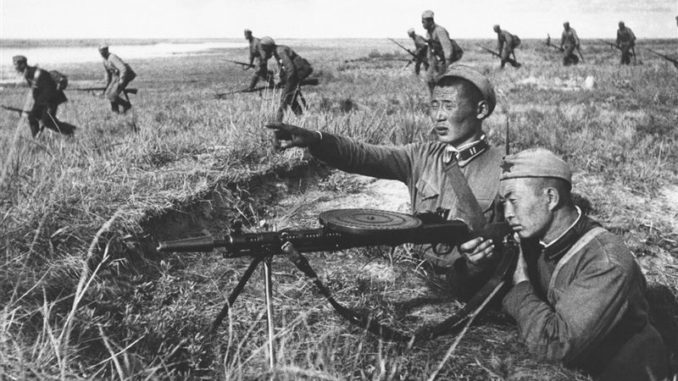
The Second World War could have had any number of dramatically different outcomes if not for the profound impact of obscure events on the course of history. A border dispute between Mongolia and Manchuria in the 1930s was one such relatively unknown conflict.
Mongolia had become a socialist state in 1924 with the assistance of the Soviet Union. The price of that assistance was a degree of control from Moscow. That degree of control increased as time went on. The Soviet Union used first China’s incursions into Mongolia then Japanese imperialism as an excuse to place troops in Mongolia. Manchuria was invaded by Imperial Japan in 1931, which installed a puppet government called Manchukuo. The border between the Manchukuo and Mongolia became disputed by Japan and the Soviets as early as 1932. Skirmishes between opposing forces over disputed territory began in 1935. Though war was never formally declared, we now know it as the Soviet-Japanese war of 1932-1939.
Fearing the ambitious Soviet Union, Japan and Germany had signed the anti-Comintern pact in 1936, cementing their alliance against the USSR. Hitler was counting on Imperial Japan to invade the USSR from the east as he was invading from the west. Stalin, however, secretly negotiated the Molotov-Ribbentrop Pact, signing the treaty on August 23, 1939. With that diplomatic move, Stalin isolated Japan from its ally Germany, just as the Soviet Red Army was about to hand Japan a nasty, history-altering defeat.
The undeclared war came to an end when the Kwantung Army of Japan (the Imperial Japanese Army in Manchuria) was decisively and utterly defeated at Khalkhin Gol, August 20-31, 1939. A stunning 75% of Japanese forces were killed in combat. Khalkhin Gol is also noted for the largest tank battle up to that time. It was also one of the last battles in which the opposing air forces both fought with a number of biplanes (but not exclusively, they each had modern monoplanes as well) and probably the last time mounted cavalry (Mongolian) was used with positive effect. Also, this is where General Georgy Zhukov earned his first Hero of the Soviet Union medal.
While the battle itself is interesting for military historians and war college studies, the remaining nitty-gritty details don’t matter. What really matters is, the Japanese loss resulted in a major policy change.
In Japan, the Imperial Japanese Army (IJA) and the Imperial Japanese Navy (IJN) were powerful forces within the government. Both were in favor of an imperialist doctrine of expansionism by military force. They disagreed on direction: the IJA favored a ‘northern road’ with the goal of seizing Manchuria and Siberia’s mineral and oil resources, while the IJN argued for a ‘southern road’ with the goal of seizing southeast Asia (particularly the Dutch East Indies for its oil) and many Pacific Islands to act as a defense buffer against the US.
They also disagreed on who the enemy was: the IJA saw the Soviet Union as the greatest threat to Japan, while the IJN saw the United States (especially the US Navy) as the greatest threat to Japan and its imperialistic ambitions.
The IJA view prevailed in the 1920s and 1930s, and the northern road doctrine was pursued. First Manchuria, then the invasion of Siberia was to follow. Had the Japanese defeated Soviet-Mongolian forces at Khalkhin Gol in 1939, the Japanese would have been ready to invade Soviet territory in 1941 when Hitler betrayed Stalin and invaded the USSR. The Soviet Union could not have survived a two-front war. They very nearly succumbed to the Nazi invasion without the Japanese at their back door. And without the USSR waging a vicious fight on Hitler’s Eastern Front, it’s unlikely the Allies could have defeated Nazi Germany and liberated Europe.
However, after the humiliating defeat of the Kwantung Army at Khalkhin Gol, the IJA northern road doctrine was politically dead. IJA political power was sapped. If that wasn’t enough, the United States and Britian imposed an embargo on scrap iron and petroleum exports to Japan in July, 1941. Those resources were critical to Japan’s ambitions, and the move strengthened the IJN position that the US was Japan’s greatest enemy. Japan pursued the southern road doctrine from that time on, which led to Pearl Harbor and the United States’ entry into the war.
Had the Japanese defeated Soviet-Mongolian forces at Khalkhin Gol in 1939, the Japanese would have continued on the northern road doctrine. Not only would they have helped Hitler defeat the Soviet Union, but Japan would not have pursued the southern road doctrine, and would not have attacked Pearl Harbor. The United States would not have entered the war, at least not when it did, and if it had it may have been too late to stop the Axis’ and their plans of world domination.
Obscure events do indeed profoundly impact the course of history.
Question of the Night: It’s summer and it’s hot… how do you keep cool?

2 Trackbacks / Pingbacks
Comments are closed.